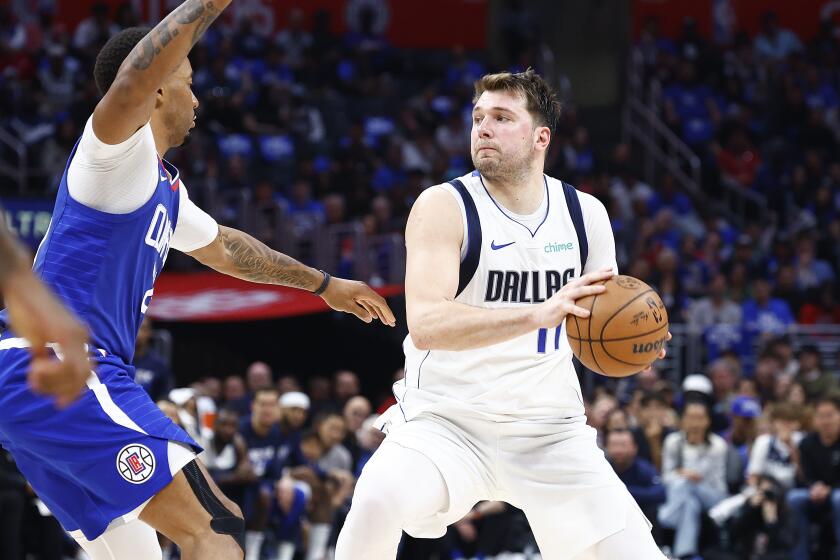Walt Disney -- hero or villain? A PBS documentary tries for a balanced portrait
Nearly 50 years after his death, Walt Disney remains a divisive figure. That 20-foot berm separating Disneyland visitors from the messy realities of the outside world might as well be the wall that divides the true believers in Disney’s innovative magic and those who find his creative output — the movies, the theme parks, the merchandising, that damn mouse — to be mainstream, cornball and sanitized.
Increasingly, though, there’s a third group — a younger generation unaware that Disney actually existed as a flesh-and-blood historical figure.
“You talk to teenagers and they think Walt Disney’s a brand, like Apple,” says Neal Gabler, author of the 2007 biography “Walt Disney: The Triumph of the American Imagination.” “As time passes, the company has become more and more disassociated from the human being who created this empire.”
FULL COVERAGE: Fall TV Guide
That may be one reason that PBS’ long-running documentary series “American Experience” finally realized its ambition to make a movie about one of the 20th century’s most significant figures. “American Experience: Walt Disney,” a two-part, four-hour documentary airing Monday and Tuesday, offers a comprehensive look at Disney’s life and the ways his work continues to influence worldwide culture. It’s a balanced portrait, lauding Disney’s achievements while also acknowledging his missteps — clashes with labor unions and his animators as well as a profound lack of social awareness.
The project’s makers — “American Experience” executive producer Mark Samels and director Sarah Colt — remain, on the eve of its release, somewhat in awe at winning consent from the Walt Disney Co. to make the movie.
“We’ve been thinking about it for a long time, but the more lawsuits and restrictions you heard about — you can’t have Mickey Mouse on a T-shirt, you can’t do this, you can’t do that — the more we felt stymied,” Samels says. Adds Colt: “It’s a visual medium. If you can’t use archives, you can’t make a documentary.”
Samels negotiated with Disney representatives for nearly a year, telling them that Disney possessed the same historical importance as the numerous presidents and innovators like Henry Ford that “American Experience” had profiled. He also took the hard line that Disney could have no editorial input into the project. Samels believes that his unyielding stance ultimately led to the project’s approval, as it absolved everyone up and down the Disney corporate chain of responsibility over the content. Days before airing, no one from Disney has seen the documentary.
“They want it,” Colt says. “We’ve just been very clear we can’t let them see it before it airs.”
What they’ll see, along with the rest of viewers, is a bevy of striking images and footage, much of it rare, that illuminates Disney’s life visually. For instance, making the contrast between the fun-loving young Disney and his withholding, imperious father, Elias, come alive is a home movie of Walt interviewing his parents on their wedding anniversary. Their exchanges are painfully awkward. So when Disney is quoted saying about his father, “I’m going to be everything he isn’t,” there’s a vivid frame of reference for the stern figure who motivated the adult Disney to yearn for all the whimsical things he didn’t receive as a child.
Like most “American Experience” docs, the Disney project was originally conceived as a two-hour film that would have followed Disney starting with his Missouri childhood and continuing through his move west with his brother Roy and their success in forming the studio. But it quickly became clear that such a streamlined approach wouldn’t work as there wouldn’t be time to do justice to the celebrated run of animated movies from “Snow White and the Seven Dwarfs” through “Pinocchio,” “Fantasia,” “Dumbo” and “Bambi,” much less the creation of Disneyland. So the decision was made to break the movie into two parts, with the 1941 Disney animators strike being the turning point splitting the two halves.
Again, Colt came across a key archival find — a recording of Disney addressing his employees, oblivious to their complaints about unfair pay and crippling workloads — telling them they didn’t need a union because he already gave them everything they needed. The audio exists because Disney, so sure he was in the right, didn’t want to be misquoted.
“It really plays out, that family image of Disney thinking he’s the dad and he’s going to say, ‘Kids, you’re misbehaving. And I know when I tell you why you can’t do these things, you’ll understand,’” Colt says. “And it just backfired.”
The first part of the documentary ends with footage of Disney standing in an office doorway at his Burbank studio with a forlorn look of distaste and dejection on his face as he watches his striking animators picketing the lot. It’s a picture worth a thousand words.
“Walt never talked about the strike,” Richard Sherman tells The Times. Sherman, who with his brother Robert wrote songs for Disney movies like “Mary Poppins,” “The Jungle Book” and the “Winnie the Pooh” featurettes, adds: “Some of the old-timers at the studio would say, ‘He was warm and open with everybody before the strike. But then he felt like his family had betrayed him.’ He was deeply hurt, I know that.”
The documentary repeatedly asserts that Disney remains a potent Rorschach test in popular culture. Tom Hanks portrayed Disney two years ago in “Saving Mr. Banks,” a Disney-produced movie about the making of “Mary Poppins” that, for some, came across as a piece of upbeat, revisionist history. Shortly after its release, Meryl Streep presented an award to Emma Thompson, who portrayed “Mary Poppins” author P.L. Travers in the film. Streep used the occasion to attack Disney, calling him a “gender bigot,” alleging he had “racist proclivities” and that he “formed and supported an anti-Semitic industry lobby.”
None of those allegations are addressed in “American Experience: Walt Disney,” though not because Colt didn’t look into them.
“I asked that question to everyone I interviewed,” Colt says, referring, specifically, to anti-Semitism charges. “But we didn’t bring it up because it was not supported by the record. It needed to be asked, but it didn’t have a place in the film.”
Adds Gabler: “The enmity toward Walt is not generated by him being an anti-Semite. Him allegedly being an anti-Semite is generated by the enmity toward Walt. There are plenty of reasons to dislike Walt Disney, particularly politically, but they don’t have much to do with anti-Semitism. Was he a gender bigot? Like almost everyone in that generation, he was. Maybe you could blame him for not being a progressive, but nobody was a progressive then.”
Gabler, whose 851-page book remains the definitive Disney biography, participated in the “American Experience” documentary and lauds it as a “visual education.” Still, he wonders if it will change the opinions of anyone familiar with the man.
“I don’t think people will watch with an open mind,” Gabler says. “If you worship Walt Disney, you’ll probably feel that the film is not worshipful enough. And If you demonize Walt Disney, you will probably feel that the film does not villainize him enough. But you can’t get at the man when you’re dealing with those polarities. There’s truth in both of them, and I think that’s what makes this movie work. You see the man as a whole.”
More to Read
The biggest entertainment stories
Get our big stories about Hollywood, film, television, music, arts, culture and more right in your inbox as soon as they publish.
You may occasionally receive promotional content from the Los Angeles Times.











